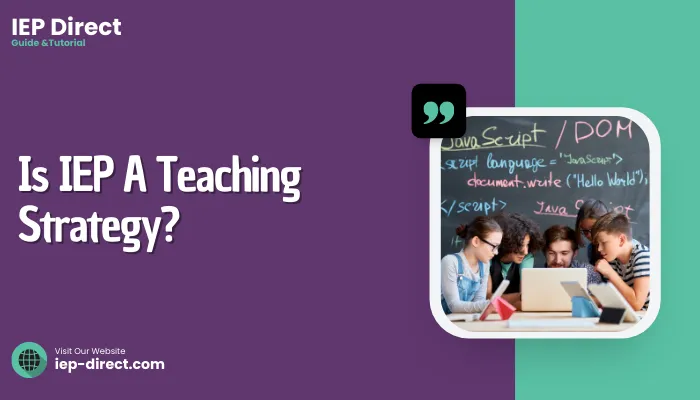Is IEP A Teaching Strategy? This is a question that often pops up in discussions about special education. It’s a good question, and to answer it, we need to understand what an IEP Direct actually is, right?
An IEP, or Individualized Education Plan, is a legal document that specifies special education and related services that must be provided to a disabled child to enable him/her to be educated. It gives a blueprint of an individual child’s learning experience based on their unique needs and learning style.
Now that you know IEP let’s jump on main topic about ” Is IEP A Teaching Strategy? “.

Is IEP A Teaching Strategy? An In Depth Look
Many people think is IEP a teaching strategy and to answer that IEPs themselves are not teaching strategies. Instead, they provide guidance for the education of children: they are maps, guides, plans, or foundations for educational programs.
In section everything is mentioned about the IEP teaching strategy as well as their main purpose behind it.
The Purpose Of An IEP
An important reason for having an Individualized Education Program (IEP) is making sure that no disabled learner who needs support in order to succeed misses out on this opportunity.
This serves as a platform for parent-teacher collaboration and other professional service providers within the school system addressing the question of is IEP a teaching strategy by demonstrating how it supports educational strategies.
- Guarantees Free Appropriate Public Education (FAPE): It assures that children with disabilities can attend free public schools appropriate for their condition.
- Sets Measurable Goals: This helps in identifying clear expectations towards which the student should work.
- Provides Necessary Services: These cover any type of assistance required by a particular student to meet his/her targets.
- Involves Parents: The strategy promotes parental involvement in taking part in school activities concerning their children’s progress.
In conclusion, an Individualized Education Program (IEP) is necessary for assisting disabled pupils, ensuring they acquire suitable education and the essential services that foster their success.
Key Components Of An IEP
An IEP includes essential components to support student success.
The following are typically found in an IEP:
Here is the content formatted in a table:
| Component | Description |
|---|---|
| Present Level of Performance (PLOP) | Indicates how disability affects general educational performance and current standing. |
| Annual Goals | Specific, Measurable, Attainable, Relevant, and Time-bound goals that students aim to accomplish. |
| Special Education and Related Services | Specific special education and related services delivered to the child. |
| Accommodations and Modifications | How the child is instructed or tested differently. |
| Participation with Non-Disabled Peers | The child will intermingle with normal classmates in a certain manner. |
| Progress Monitoring | Clarifies the format of reporting on student academic progress. |
| Transition Planning | Refers to planning beyond high school, not just life after graduation. |
Therefore, Understanding these IEP components helps ensure effective support and progress for students with disabilities, guiding their educational journey.
Contributors To IEP
IEPs are written for children who have disabilities qualifying them for special education programs. To be eligible, a child must have a disability that affects his/her learning and requires specialized instruction.
A team of people who create an IEP includes:
- Parents or guardians
- General education teachers
- Special education teachers
- School administrators
- Related service providers (e.g., speech therapists, occupational therapists)
- The student (when appropriate)
Therefore, An IEP is a living document that determines how well it supports a child’s dynamic needs, as it can change over time.
Understanding The Difference
We have tackled the issue of whether an IEP can be regarded as a teaching strategy; nevertheless, this does not mean we should ignore any details concerning its significance in terms of educational practices.
It doesn’t end there though, let’s take it further into considering more about how IEPs work together with teaching strategies.
IEPs vs. Teaching Strategies
Is IEP A Teaching Strategy? No, rather it is considered in part as planning, while teaching methods assist in implementing such plans.
Consider it as creating a house. The IEP is analogous to the house’s blueprint which specifies its structure, size, and materials. These are tools that builders use in order to build the house.
IEPs Support Teaching Strategies
An Individualized Education Plan (IEP) is of help in selecting and implementing effective teaching strategies. Educators can identify suitable teaching strategies for a student by indicating their strengths, weaknesses, and goals.
checkout this points to understand more better:
- Identifying Student Needs: The child’s specific learning challenges and strengths are outlined by the IEP’s present level of performance (PLOP).
- Setting Clear Goals: Instruction must always be focused on annual goals from the IEP.
- Matching Strategies to Needs: Goals and learning style of students should shape selection towards teaching strategies.
- Monitoring Progress: This is done through the progress monitoring component in IEP as a way of assessing the effectiveness of teaching strategies.
Therefore, an IEP guides effective teaching by identifying needs, setting goals, matching strategies, and monitoring progress for student success.
IEPs in Action: Real World Examples
Some examples will be provided showing how different educational settings apply various teaching strategies based on an individual education plan (IEP) they possess.
Below are real world examples:
A student with dyslexia
- IEP Goal – Improve reading fluency and comprehension.
- Teaching Strategies – explicit phonics instruction, multisensory learning, assistive technology use.
A student with ADHD
- IEP Goal – Increase attention span and organization skills
- Teaching Strategies – behavior management techniques, visual organizers, breaks between class periods etc.
A student with autism
- IEP Goal – Improve social communication skills
- Teaching Strategies – Social stories; role-playing; peer tutoring
Components of the IEP And Corresponding Teaching Strategies
| IEP COMPONENTS | TEACHING STRATEGY EXAMPLES |
|---|---|
| Present Level of Performance | Diagnostic Assessments, Observational Data |
| Annual Goals | Differentiated Instruction, Explicit instruction |
| Special Education and Related Services | Speech Therapy, Occupational Therapy, Counseling |
| Accommodations and Modifications | Extended Time, Assistive Technology; Modified Assignments |
However, IEPs are dynamic documents that should be reviewed and updated regularly to ensure that the teaching strategies continue to meet the ever-changing needs of the child.
Conclusion
‘Is IEP A Teaching Strategy?’ We have explored this deeply clarifying that while it isn’t a teaching strategy per se, an IEP provides an essential means of facilitating effective instruction.
They are more than just legal documents but they help improve educational outcomes too. To make learning inclusive and successful, teachers should understand IEPs’ role and their intersection with teaching approaches.
